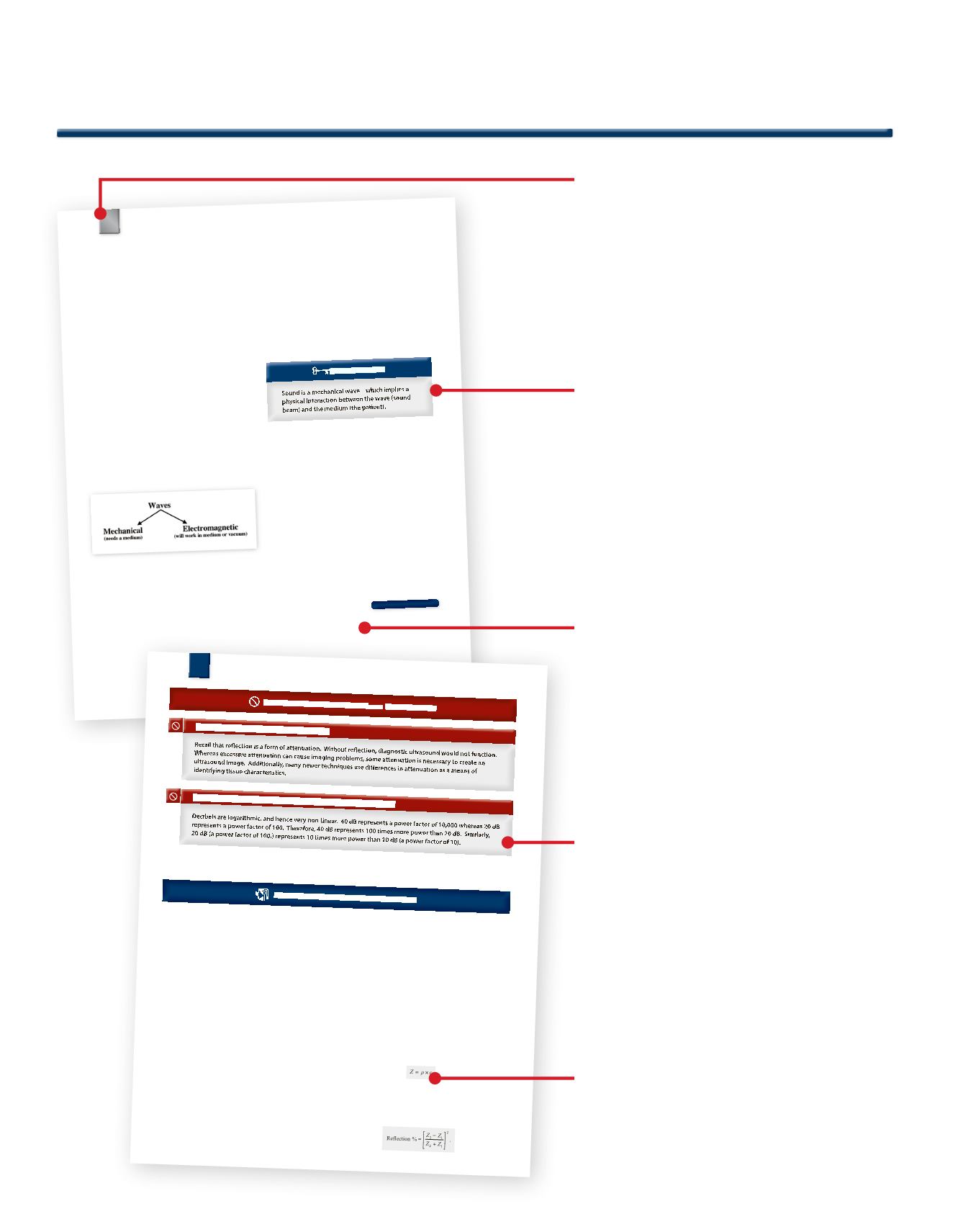
Ultrasound Physics & Instrumentation
viii
8
Level1
BasicUltrasoundPhysics
All of these waves clearly transport energy from one location to
another. Also, interpreting the characteristics of these waves will
yield informationabout thesource. Forexample,is thewavestrong
or weak, does it vary quickly, can it travel a long distance, can it
penetrate through anobject in itspath,what effectdoes ithaveon
themedium (material) throughwhich itpropagates?
3. Classi cation of Waves
3.1Bene t toClassi cations
Classification schemes areuseful as a technique to subdivide large
groups into smaller groups.
ebenefitof subdividing a topic ac-
cording to similar characteristics is a simplification in the amount
of information thatmustbe retained.
Considerhow colleges subdivide students according to the yearof
graduation and then subdivide each year into specific majors. By
dividing the entire studentbody intoyearsof graduation, the clas-
sificationof freshman,sophomore, junior,or senioralone tellshow
muchmore time there isuntil the individual studentwillgraduate.
By further dividing the class into majors, the specific curriculum
is somewhat defined, limiting the number of elective classes an
individual student can take.
Forwaves,oneusefulclassification isbasedonhow thewavepropa-
gates (travels).
efirst classificationdistinctionwewilldiscuss is
the conceptof an electromagneticwaveversusamechanicalwave.
Fig.1
Classi cationofwaves
3.2Electromagnetic (EM)Waves
An electromagneticwave is a transferof energy through avarying
electricalandmagneticfield. Some examplesof EMwavesare:
•
light
•
heat
• X-rays
•
gamma rays
•
television signals
eequations thatdefineanddescribeelectromagneticwave theory
and propagation are very complex and are generally confined to
higherordermathematics. Fortunately,sound isnotanelectromag-
neticwave,soyouwillnotberequired toknowmuchmore than the
absolutebasicsabout electromagneticwaves.
One of the defining characteristics of an electromagnetic wave is
that it can travel both through a medium (a material such as air,
water, tissue,metal,etc.) aswell as through avacuum (the absence
of amedium,or space). You arenot required toknowmuchmore
aboutelectromagneticwaves than thisonedefining characteristic.
However, you should be very appreciative of the importance of
this one characteristic. If electromagnetic waves could not travel
throughavacuum likespace,sunlightwouldnotreach theearthand
youwouldnotexist to read this textbookwhich,withoutanauthor,
wouldalsonot exist.
KEY CONCEPT
3.3MechanicalWaves
A mechanical wave requires a physical interaction.
e medium
affects thewave,and thewave affects themedium. Inotherwords,
mechanical waves must have a medium,or the wave cannot exist.
From the first list of waves, described in Section 2.2,ocean waves,
sound, the vibrationof a guitar string,andpeople at aballpark are
allexamplesofmechanicalwaves.
e term mechanical as a classification is very useful since the
word itself invokes some relationships critical forultrasound. For
example, the fact that the wave is mechanical indicates that the
wavewill interactwith the tissueof thepatient (themedium),and
that the tissue of the patient will interact with the wave. As a re-
sult,we should expectpotential changes in thepatient as thewave
propagates. Furthermore,we shouldalsoanticipate changes to the
characteristics of the wave with propagation through the patient.
In fact, each of these “interactions” is so important that they will
spawnentirechapters:onechapterentitledbioeffects,and theother
chapter entitledattenuation.
4. Conceptual Questions
AnswersPg.537
1.
Electromagneticwaves
a) donot transfer energy.
b) cannotpropagate throughamedium.
c) include soundwaves.
d) noneof theabove.
2.
Mechanicalwavesmusthavea____________ topropagate.
72
Level3
AdvancedTopics
•
Attenuation implies a decrease in signal strength and
occurs through absorption, reflection, and refraction.
•
Absorption is theconversionofenergy intoheatwithin
the medium.
•
Absorption is thedominant formofattenuation in“soft
tissue.”
•
Absorption increases exponentially with increasing
frequency.
•
Fluids tend to absorb energy much less than tissue.
•
Bones absorb at a significantly higher rate than “soft
tissues.”
•
The typeofreflection thatoccursatan interfacedepends
on the wavelength relative to the surface geometry.
•
If the surface is large, smooth, and flat with respect to
thewavelength, specular reflectionoccurs (mirror-like
reflection).
•
If the surface is rough with respect to the wavelength,
scattering occurs.
•
If the reflectingstructuresaresmall relative to thewave-
length (such as occurs with red blood cells) Rayleigh
scattering occurs.
•
Specular reflection is highly angle dependent and also
the primary cause of most imaging artifacts.
•
Rayleighscattering isaveryweakreflectionmechanism.
•
The amount of scattering increases with increasing
frequency. Since the wavelength decreases as the
frequency increases, the surface appears “rougher”
increasing scattering.
•
Although scattering intensifies with increasing fre-
quency, absorption increases even faster with higher
frequency. This is the reason you should use lower
frequencies forDopplerunless imagingverysuperficial
blood flow.
•
The amount of reflection that occurs at an interface is
determinedby theacoustic impedancemismatchacross
the interface.
•
The acoustic impedance of a material is given by the
density times the propagation velocity:
•
Higheracoustic impedancemismatchesproducegreater
reflection.
•
You should know the equation for percentage energy
reflection based on acoustic impedance mismatch:
Misconception #2: 40 dB is twice as much power as 20 dB.
Misconception #1: Attenuation is bad.
COMMON MISCONCEPTIONS : ATTENUATION
CHAPTER SUMMARY : ATTENUATION
Key Features
Levels
Topics are divided into levels, allowing readers to
progress at a pace appropriate to their background.
Key Concepts
Critical concepts are summarized to improve
comprehension and enhance retention of material.
Common Misconceptions
Common points of misconception are summarized
to clarify areas of ultrasound physics that frequently
give students the most difficulty.
Important Equations
Key physics equations are highlighted to
facilitate efficient identification and review of
critical concepts.
Conceptual Questions
Conceptual questions are integrated into the
material, allowing the reader to assess their level
of understanding as they progress through
the chapter.


